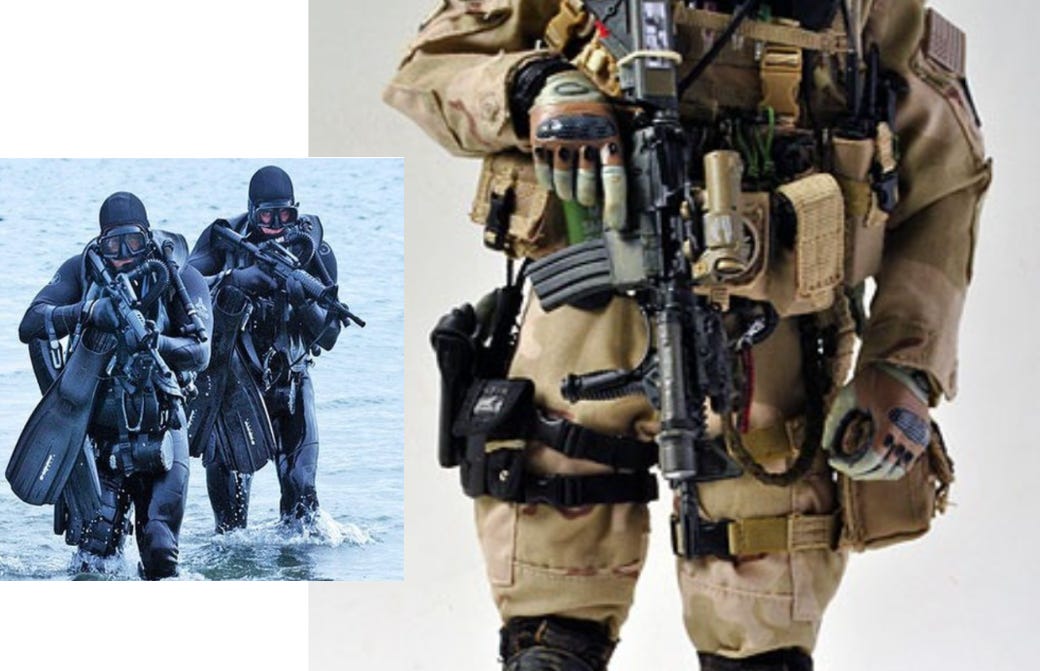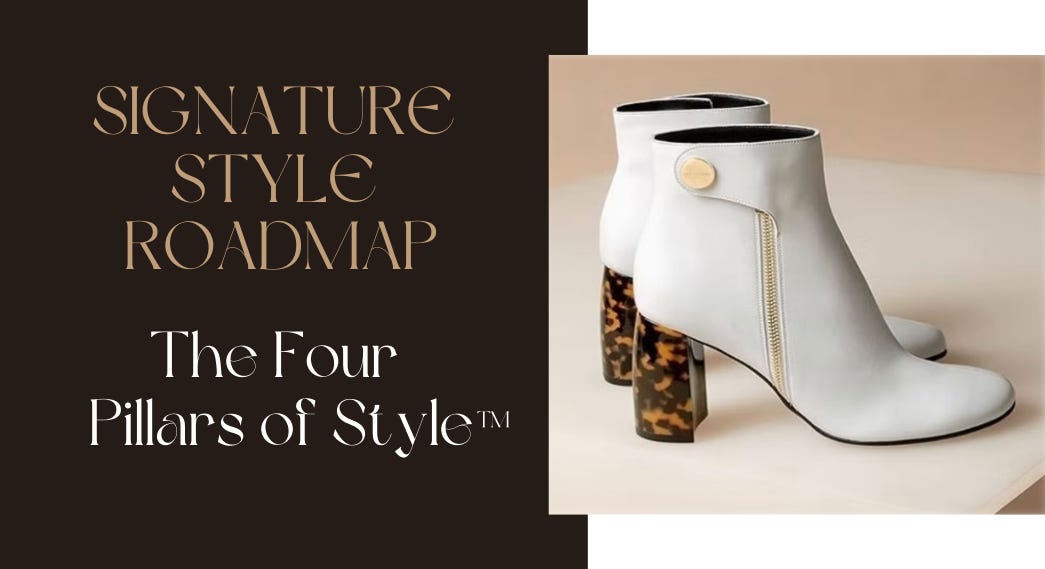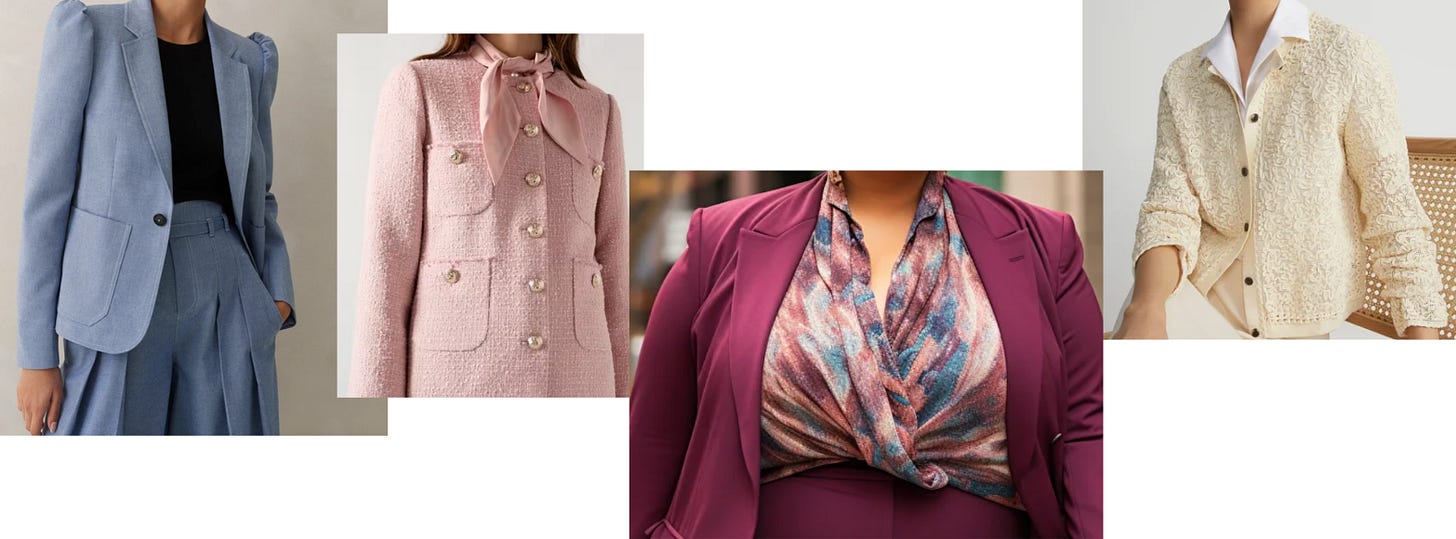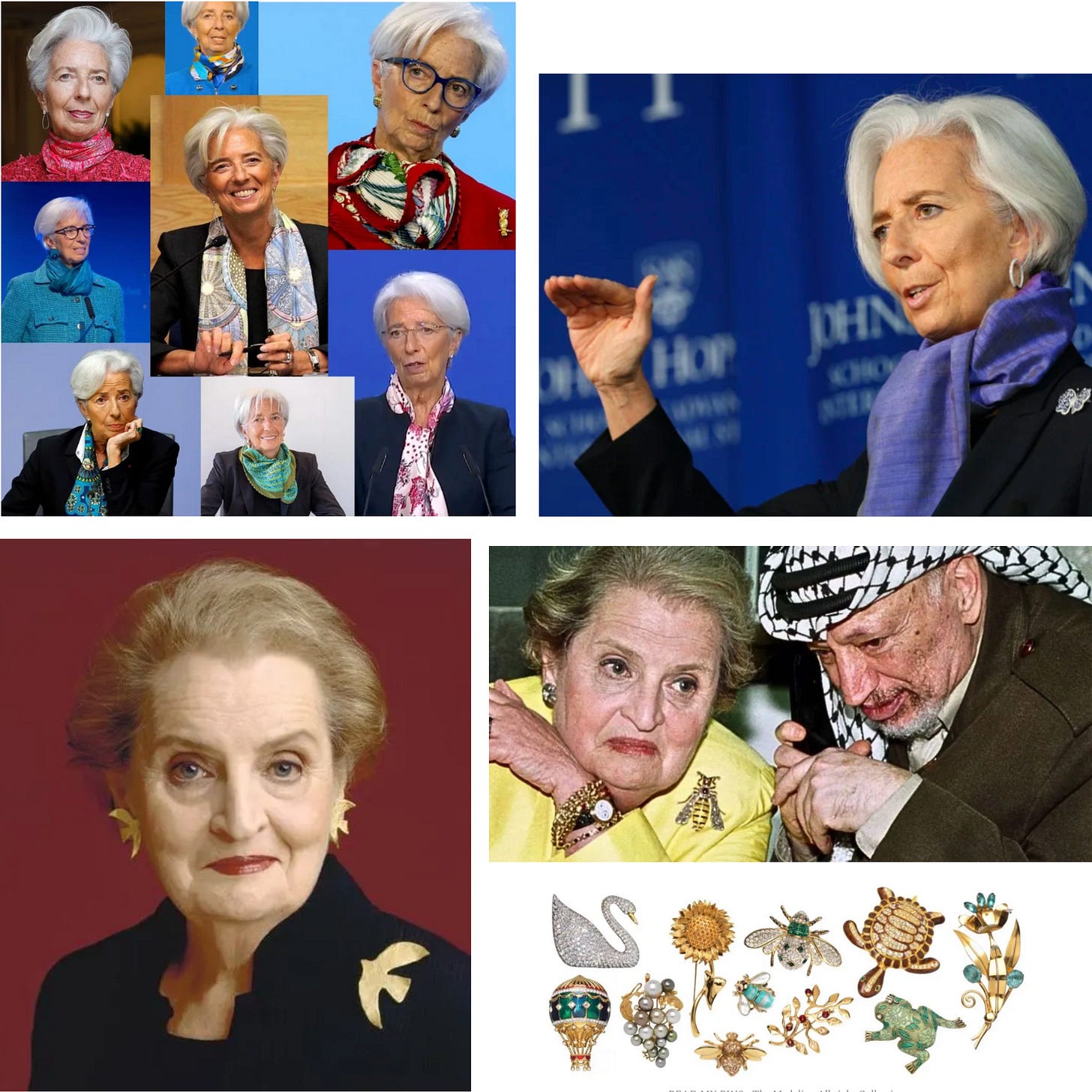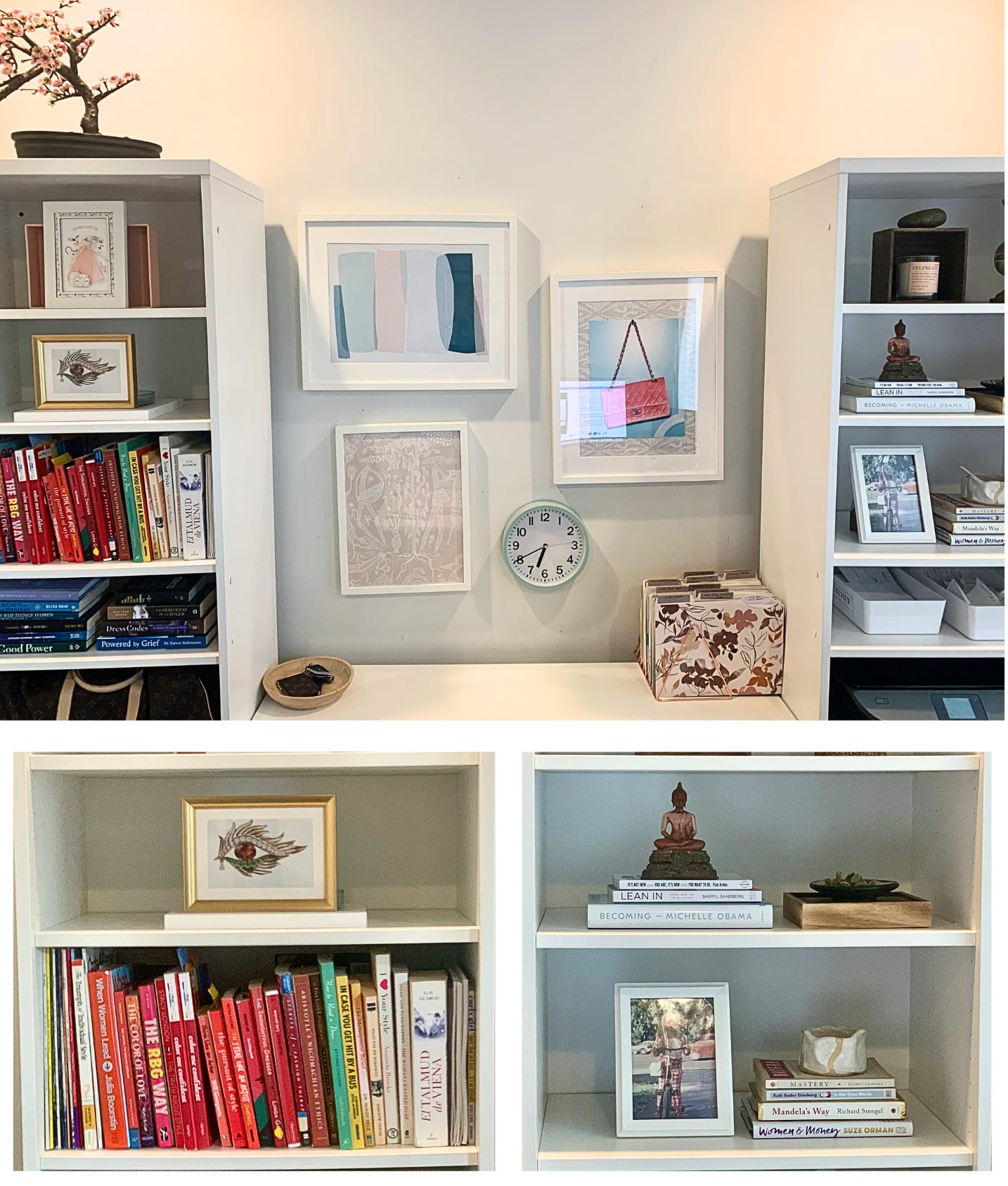SS 39: Style as Strategy™ - What to Wear for Your Virtual Interview
If you're navigating a career pivot or stepping into a new leadership role, this article is for you.
This week, I gave a virtual presentation to a recruiting company that works with C-suite executives. As I reflected on the conversation, I realized this topic needs a wider audience. It deserves to live here—inside the Style Sessions library—because it’s a question so many of us face, yet rarely prepare for with strategy.
Let’s talk about what to wear for your virtual interview.
Imagine this: You’ve got the email. The interview is confirmed.
You pause. You read it again. There are no details yet—no title, no description, just a time and a screen link.
You take a breath, walk to your bedroom, open the closet doors…and stand there.
Heart racing. Mind scanning every option.
You stare at your clothes, hoping—wishing—they’ll somehow read your mind and choose themselves. That they’ll leave their hangers and assemble the perfect outfit. One that says all the right things—before you say a word.
Let’s pause there.
Because here’s the truth:
Style isn’t about wearing pretty clothes.
It’s about how you communicate without speaking.
It’s how you align your presence with your purpose.
And ultimately, how you shape what you want to create.
For high performers and professionals, style is always strategy.
It’s like oxygen: essential, precise, intentional.
For amateurs? It’s barely on the radar.
High Performers Use Style Strategically
Let’s look at some examples.
Serena Williams.
One of the most influential and groundbreaking athletes in history. She didn’t just win—she redefined the game of tennis. Under her belt, she has 23 Grand Slam titles and six consecutive years as world No. 1; her legacy is undeniable.
Her preparation extended far beyond the court. Her style and outfits were curated specifically for every match, considering the type of tournament, the city, the weather, her opponents, the stand she wanted to give to herself (what she wanted to create), and the clear message she wanted to deliver to the audience and fans.
Every detail, head to toe, was strategic.
Taylor Swift.
A creative and business force—artist, businesswoman, philanthropist, icon.
During her Eras Tour, she performed 44 songs across 3.5 hours, changing outfits every 21 minutes to reflect the evolution of her music and message. Each look was meticulously styled to embody the spirit of the album—a visual symphony of eras, emotion, and deliberate storytelling.
Let’s look at the Reputation Album. An album about vengeance, reinvention, and ultimately, the rediscovery of love.
What did she wear to express it?
A black-and-red bodysuit designed by Roberto Cavalli. Snakes slithered up her body, wrapping around her neck—symbols of danger, rebirth, and power. One leg covered, the other bare. One side shadowed, the other emerging into light. A visual metaphor for transformation: from darkness to love. In this outfit, there is a narrative. Nothing random. All intentional.
The Navy SEALs.
The U.S. Navy’s elite special operations force, known for executing the most high-stakes, high-risk missions in modern history. These are men trained for extreme conditions—mentally, physically, and strategically. For example, a team of just six carried out the operation that found and eliminated Osama Bin Laden after a decade-long manhunt.
And their uniforms? Not optional. No fluff. No guesswork. Not decorative.
Each SEAL carries up to 70 pounds of gear: ammunition, medical supplies, night vision goggles, breaching tools, and communication systems to coordinate airstrikes.
Their gear is designed with surgical precision for each mission.
They train in it. Sleep in it. Operate in it. It becomes an extension of their bodies. Their lives are on the line. Clothing isn’t aesthetic. It’s life or death.
Now, back to you.
The interview is on the calendar. The role is defined. And the question still stands: What do I wear?
This isn’t a guessing game—it’s a moment for strategy.
Let me introduce you to a framework I’ve developed, refined, and proven over years of working with high-performing women leaders.
Your Signature Style Roadmap / The Four Pillars of Style™
A clear, elegant, and proven framework to help you dress with purpose, presence, and impact—no matter what’s on the line.
1. Own Your Body Design
Your body is not a problem to solve. It’s a blueprint made of lines, shapes, and proportions. Most of these structures are not going to change. They’re facts to work with.
Let me give you a few examples:
• The length of your neck isn’t going to change. But once you understand it, you can choose collars and necklines that elongate, balance, or highlight in all the right ways.
• Your bone structure is set. It influences the scale of prints, the size of accessories, and even the sharpness of tailoring that suits you best.
• Your waistline, whether high or low, short or long, is part of your natural architecture. Learning how to dress around it unlocks a new level of balance and ease.
• Your torso length shapes how you combine tops and bottoms.
• The relationship between your facial features and head size? That’s what guides the scale and shape of jewelry, earrings, or necklines that truly flatter.
The more you know, the less you second-guess. And this is where style becomes clarity.
Now let’s apply this to your Virtual Interview.
1. Dress head to toe—even on Zoom.
Yes, you're on screen—but how you feel is shaped by what you wear beyond the frame. Structured pants, a skirt, or a full dress cue your body to show up with intention. You carry yourself differently when you’re fully dressed.
2. Wear real shoes.
Not house slippers. Not sneakers. And definitely not Crocs. Wear the shoes you’d actually choose for an in-person interview, because they do more than complete the look.
3. Add a third piece.
A well-cut blazer, jacket, or tailored vest completes your outfit. A jacket reads as authority and protection. Because of its structured shape, it creates distinct lines for the eye to follow, guiding attention to your face. On a video call, that visual direction is essential.
2. Know Your Color Palette
Your most flattering colors aren’t random—they come from the natural harmony between your skin, eyes, and hair.
Once you know what it is, everything shifts. No more chasing Pantone’s “color of the year.” No more second-guessing in front of the mirror at Nordstrom or Veronica Beard. No more random online orders that end in disappointment and returns.
You begin to choose and shop with intention.
And finally feel like your clothes are working for you.
Because color is never just visual—it carries meaning.
And that meaning shifts across industries, companies & cultures.
I’ve explored this further in Color is Culture and Color is Culture Part II, where I dive into how colors signal identity, values, and emotion across global and multicultural environments.
Now let’s apply this to your virtual interview.
• Start by asking about the company’s dress code. Don't stop there if the answer is vague—“business casual”. Research their website, branding, and marketing. Their visual language holds clues.
• Choose hues that align with your color palette and the culture you’re stepping into. A law firm is not a creative agency. Context matters.
• Use contrast intentionally. Make sure you stand out from your background—clearly but subtly.
• And reconsider black. Yes, it’s powerful. But it can also create emotional distance. Navy is often a better choice—grounded, strong, and inviting.
3. Understand Fabrics
The quality of the fabric determines how a garment fits, holds its shape, and performs under pressure. On screen, poor fabric shows. It wrinkles, pulls, clings, and distracts. Quality fabric moves with you—and speaks for you.
Invest in quality fabrics.
They hold their structure, feel more comfortable, elevate your look, and will stand the test of time.
Buy less. Buy better.
There are already too many clothes on the market. We don’t need more. It’s better for the environment, better for the industry, and better for us as consumers.
4. Embrace the Power of Accessories
Accessories do more than complete a look.
They tell stories. They hold memory. They signal meaning.
The right piece can spark conversation, mark a moment, and make you unforgettable. They carry energy, and when chosen intentionally, they can give you something to hold onto when the stakes are high.
Let me show you what I mean.
Christine Lagarde, former President of the International Monetary Fund and now President of the European Central Bank, is rarely seen without one of her signature scarves. Not flashy. Not trendy. Structured. Elegant. Distinctly hers.
Her scarves are more than style—they're a signal. Of consistency. Of control. Of commanding presence. I wrote more about her in The Power of the Scarf, where I explore how her accessories speak as clearly as her leadership.
Madeleine Albright, the first woman to serve as U.S. Secretary of State, famously used pins as a language of diplomacy. A bee for a high-stakes negotiation. A turtle for patience. A brooch to send a message—without saying a word.
When asked how she was doing, she said, “Read my pins.” And the world did.
More of her story is in my article, Read My Pins.
And to bring this into 2025, let me share a recent example.
A brilliant executive I worked with has deep roots in Taiwan, though she was born and raised in California.
As we shaped her wardrobe, I wasn’t just looking for something visually striking—I wanted to find something that would ground her style in identity.
I asked about her background. Her childhood. She lit up as she spoke about her heritage, her family’s traditions, and her connection to Taiwan.
Then I asked, “Do you own anything special from there?”
She paused. Then said, “Actually… I do. I have this red coral necklace. But I never wear it—I don’t know how.” She brought it out—and the moment I saw it, I knew. “This is it.”
That necklace, rich in color, weight, and memory, became the foundation of her signature look. We layered it with modern pieces, gave it context and edge, and it transformed.
Now she wears it to high-stakes meetings, presentations, and client pitches.
Because it’s not just beautiful.
It carries her story. Her family. Her roots.
It reminds her who she is—and what she brings.
That is the power of a well-chosen accessory.
Include Your Background
The final visual element to consider for your virtual interview is your background.
What is your interviewer seeing? In just a few seconds, often unconsciously, they begin forming a story. Like a stage in a theatre, your background sets the tone the moment the screen comes to life. It creates atmosphere, signals intention, and frames who you are—before you say a word.
In a virtual setting, your environment becomes part of your outfit.
It shouldn’t compete or distract. It should support your presence and add to your story. Unlike an in-person interview, where you enter their space. ere, they’re stepping into yours. And you have complete control over what they see.
Here’s my office background as an example:
I designed it using the Four Pillars of Style™
• The structure of the room reflects the body.
• The color palette sets the tone.
• The materials speak to quality.
• And the accessories—books, objects, art—are intentional and personal.
When I step into this space, I feel grounded, focused, and ready to create.
And even on the days I don’t, it holds me up.
Your space should do the same. Let it speak before you do.
Let it support the leader you are, and the role you're ready to step into.
This is your moment. Make it yours.
Use what you’ve learned here to create what you want—because it works.
Because it’s not just style. It’s strategy.
And if you need support refining your signature style, connect via my website: www.susanaperczekstyling.com







